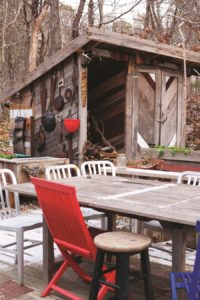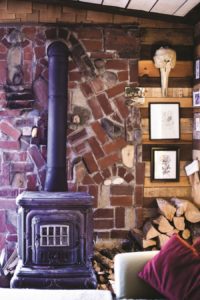Daniil Zakharevich’s handcrafted house on a dirt road in Provincetown appears to grow out of the surrounding woods. Using found materials, he has designed, renovated, and built an eclectic space with fluid boundaries between indoor and outdoor spaces.
The outside is dominated by a tiered patio constructed with a patchwork of reclaimed lumber. A table and multicolored chairs are in the center of the patio and raised flower beds and a greenhouse skirt the edges. A brick walkway leads to the bungalow-like structure he shares with his girlfriend, Sofia Cabanas.

The motif of reclaimed materials dominates the cozy, low-ceilinged interior. It was originally a cinder-block cottage; Zakharevich retained one cinder-block wall, painting it white, while he covered others with plywood and then a variety of wooden strips, creating a warm, earthy palette. One closet door makes a striking composition from found wood, with large white planks crisscrossing diagonally among smaller strips that seem to move in various directions.
Zakharevich, a fisherman originally from Belarus, wanted to respect the “old Provincetown” vibe of neighborhoods of bohemian summer cottages he’d read about in histories of the town. That’s why, he says, “I didn’t want to make anything out of place with materials that aren’t common or local.
“It’s easier to make something with three two-by-fours and a piece of plywood,” Zakharevich says. Instead, he has taken the hard road, scouring dumpsters, construction sites, and beaches for used wood and then doing the tedious work of removing nails, sanding, and cleaning it before finding just the right use for it.
He’s guided by a few principles in this quest for reclaimed wood. The main thing is, quite simply, that “it’s pretty to look at,” he says. But he also finds solace knowing that “I’m not cutting another tree.”

Collecting and repurposing has become a way of life for him and Cabanas. As we spoke, she arrived from a walk with a few pieces she’d found on her way home.
Even at sea, Zakharevich manages to find things for his home. Many of the rocks for a cubist arrangement of rock and brick that defines a hearth behind his woodstove were caught in the dredge he uses to harvest scallops from the sea floor. “The bricks were part of an old chimney that was knocked down,” Zakharevich explains. “I found pieces outside. It was part of the house and destroyed and now it’s back in the house. It felt good to bring it back in.”
One of his favorite pieces of driftwood, positioned above an oversized window, was also caught in the dredge, its surface weathered from the sea into a richly textured topography, streaked with rust from disintegrating nails.
Lamps constructed from the serpentine branches of locust trees bring the outdoors inside. Hunting in the woods for specific sizes, Zakharevich found what he needed for a bedside lamp and a larger piece in the main room, from which bare bulbs hang.

The couple’s circle of local friends have contributed to the house as well. Most of the doors in the house are from a neighbor who collected them from estate sales. After a failed attempt to make a patio with oak masonry palettes (they quickly rotted), he started over with mahogany from an old deck a friend was taking apart. “It helps to have friends like this,” he says.
Cabanas shares Zakharevich’s love for peculiar objects. One room of the house is used for her art studio, where her own paintings and projects hang alongside works by local artists, including a small landscape by Pete Hocking and an assemblage sculpture by Matt Millett.

In her own work, Cabanas often paints packaging, such as a box of Band-Aids or a can of sardines, in exquisite detail. The gouache-on-paper paintings suggest pop art in their imagery, with an intensity of execution reminiscent of Indian miniature painting.
Cabanas arrived in Provincetown when the world was just starting to lock down because of the pandemic and found inspiration in the creative community. Zakharevich had arrived a few years earlier, first as a J-1 student in 2009, and then, in 2013, as a year-round resident, after working in New York City restaurants.
“I met a Provincetown that I somehow knew existed,” he says. “I learned the history of the town and got attached to it.” His house tells the story of that attachment. Its materials are part of an economy of frugality and generous exchange, products of the woods and the sea, and things lost and reclaimed.
Standing next to his house, Zakharevich sums it up this way: “It’s a representation of a life of a person in Provincetown at this time.”



